Bali. Bali is one island in Indonesia which so much cultures and we can find it in another places. We cant deny it if Bali has great influence from Hindunese which originally come from outside of country. However after all, Hinduism in Bali is very different from original one because its also has some influence from another religion and beliefs.
Balinese Hinduism is also known as Agama Hindu Dharma, which originated from Java and as result of blend which from Shivaism and Buddhism. This blending is perfectly accepted in Bali as the saying goes, “The truth one, the interpretation, multiple”. In there, the indegeneous beliefs manifest in believe that nature is “power” and each element is subject to influence from spirits.
Read also:
Beside the great scenery which attracted tourists, Bali also has lot ceremonies which make this island as special one. Some ceremonies are really sacral, some only be held anually, monthly, and so on. Certainly every ceremony has their story between it and that why its fun to know and learn more about the culture.
For now, we will talk about some ceremonies in Bali, which symbolized as unique one and we can find it as traditional and culture one. So, what kind of ceremony we can find out in there?
1. Nyabutan Ceremony
 Babies in Bali treated rather special because for the first three months they dont allowed to touch the earth. Babies are considered to be achored to the spiritual world when they already 105 days old. At three months of age, a sacred Balinese Hindu ceremony is carried out to celebrate the first time a Balinese baby is allowed to touch the floor.
Babies in Bali treated rather special because for the first three months they dont allowed to touch the earth. Babies are considered to be achored to the spiritual world when they already 105 days old. At three months of age, a sacred Balinese Hindu ceremony is carried out to celebrate the first time a Balinese baby is allowed to touch the floor.
Because the ceremony is sacred one, this ceremony only invited close family and friends also the priest. The priest will bless he children with the holy water and after that, the children’s feet finally can touch the Mother Earth. The baby usually also given gifts of jewellery. This ritual also include so many symbols and sacred blessings which speaks by the priest.
Read also:
2. Tooth Filling
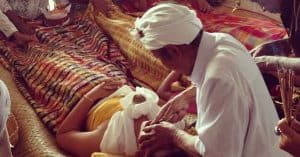 Tooth filling is one of the biggest ceremony in Bali which also known as Metatah or Mepandes in high Balinese language also belonging to Manusia Yadnya (Ceremony for humans). This important life-cycle event usually occurs when a Balinese boys or girls reaches puberty – a girl’s first menstruation or when a boy’s voice changes and if not it must take places before the marriage day. This ceremony also as a symbol for children to leave their childhodd and enter adulthood. Tooth Filling usually take time around 10-15 minutes with the sangging (traditional dentist) have a big responsibility to make this ceremony as successful one.
Tooth filling is one of the biggest ceremony in Bali which also known as Metatah or Mepandes in high Balinese language also belonging to Manusia Yadnya (Ceremony for humans). This important life-cycle event usually occurs when a Balinese boys or girls reaches puberty – a girl’s first menstruation or when a boy’s voice changes and if not it must take places before the marriage day. This ceremony also as a symbol for children to leave their childhodd and enter adulthood. Tooth Filling usually take time around 10-15 minutes with the sangging (traditional dentist) have a big responsibility to make this ceremony as successful one.
The sangging job is here to filling down the canine teeth which represents animal like characteristic in human. To make this done, the sangging have to place small piece of sugar cane in the corner of the mouth to keep the jaw open during the process. Tooth Filling is supposed to prevent humans from having the sad or destructive desires, including from dama (lust), lobha (greed), kroda (anger), moha (anxiety), manha (concern), and matsarya (envy). This ceremony also need of lot money so some people have to delay this ritual until they have enough money.
3. Traditional Wedding
 Like in another places, weddings are very important life event of Balinese because theyre an implementation of Yadnya way to harmonize the material and spiritual words. This wedding ritual also known as Pawiwahan and it wont be complete ceremony until the bride and the groom are regarded as full citizens of their banjars (villages) with all the rights and obligations there.
Like in another places, weddings are very important life event of Balinese because theyre an implementation of Yadnya way to harmonize the material and spiritual words. This wedding ritual also known as Pawiwahan and it wont be complete ceremony until the bride and the groom are regarded as full citizens of their banjars (villages) with all the rights and obligations there.
The wedding also not just an union with their spouse but also become a spiritual milestones. Before the milestones can be reached, the wedding has some sequences which determined by the priest and including desa, kala, and patra (the right place, time, and circumstances). Usually for the higher caste Balinese, they deliberately look for a partner who are came from same caste so they follow the husband’s name; and if the husband has higher or lower caste than the wife, the wife status will be upgraded or downgranded to the husband’s caste.
The procession of Balinese wedding is unique one because its has several phases before the reception. The first step is about to meet the parents so both sides of the family members will meet and know each other also can decide to make arrangemets for the wedding day – especially about the best time and place for wedding. After that, the groom’s family need to visit the bride’s family again and bring some gifts and offerings which include foods and clothings – and dont forget about the exchange rings to signify the unity.
When time to pick up the bride coming, it starts with praying procession at the home of the groom and continue with go to bride’s house. After arrive at bride’s house, the bride will join the groom as well and sit together also surrounded by their parents. This part also known as Gedong Bethel, its when parents give advice to new couple. The wedding is usually held at the groom’s house and attended by the family members, relatives, also neighbours.
Read also:
4. Ngaben
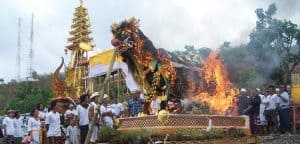 For Balinese and the spiritual perspectives, death is no less essential to life and as part of continous cycle: birth – life – death. Ngaben is also known as Balinese cremation ceremony, which is a ritual when Balinese people follow usherring the passion person into their next life. The day of the cremation always take place which selected by the priest and will be based on the Balinese calendar.
For Balinese and the spiritual perspectives, death is no less essential to life and as part of continous cycle: birth – life – death. Ngaben is also known as Balinese cremation ceremony, which is a ritual when Balinese people follow usherring the passion person into their next life. The day of the cremation always take place which selected by the priest and will be based on the Balinese calendar.
The body of the deceased will be placed at Bale Delod, as he were sleeping and the family will continue treat him as he were still alive and yet sleeping. The ritual usually companied with traditional music, which is Angklung. The climax of the Ngaben is the burning of the Wadah, using fire originated from holy source and after it being deceased, it would be reincarnation in the future. The combution ash from the body will be taken and put in the coconut and will be brought to shore.
Commonly, each family or person needs around 15-25 million rupiah for an individual ceremony with mass ngaben they will only spend is not more than 5 million rupiah. For the family with financial sufficiency, this ceremony could be done as fast as possible even they have to need the best day to do that and until the determined day, the body will be kept at home. Because the preparation can take several months and need lot of money, theres alternative way is in one village hold cremation ceremony together at one time when the financial burden is spread among all of these involved.
Read also:
5. Nyepi
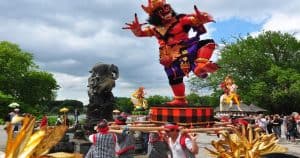 Who doesnt know about Nyepi? Nyepi is the third day of Balinese new year and also known as day of silence. In this day, everything is closed, no flights sceduled, and no one cant leave Bali at the moment. Nobody will be allowed on the beaches or the streets and the only exception for this day are security guards and emergency vehicles.
Who doesnt know about Nyepi? Nyepi is the third day of Balinese new year and also known as day of silence. In this day, everything is closed, no flights sceduled, and no one cant leave Bali at the moment. Nobody will be allowed on the beaches or the streets and the only exception for this day are security guards and emergency vehicles.
Nyepi is also meaning as to keep silent and falls on the day after the dark moon of the spring equinox when the day and night are of approximately equal duration. Nyepi day is a day that the Hindu Balinese dedicated theirself completely to connect more deeply with God through a prayer, fasting, and medication with an additional layer of instropection to self, and also pualute personal values such as love, truth, patient, kindness, and generousity.
in this ceremony, locals will build Ogah-ogah, the demonic effigies that will be paraded through the streets and later burned to banish evil spirits and restore balance. People will run through making lots of noise also the feasting and danang will take place on the street. Afterwards, the next day after Nyepi which also known as Ngembak Geni, the business will return as usual to the island and some locals will visit their families members also friends to ask for forgiveness for the past deeds and together enjoy the a feast of traditional Balinese food.
Read also:
6. Galungan and Kuningan Day
 Galungan is another major Hindu festivals in Bali and also local Balinese public holiday that last for three days. The Galungan day has religious meaning as celebration of the victory between good over evil, exactly Dharma against Adharma. Its also become big family day when extended family is gather together. The first day of the ceremony which also known as Penampahan Galungan, where its not an actual celebration but a big preparation for the next day ceremony.
Galungan is another major Hindu festivals in Bali and also local Balinese public holiday that last for three days. The Galungan day has religious meaning as celebration of the victory between good over evil, exactly Dharma against Adharma. Its also become big family day when extended family is gather together. The first day of the ceremony which also known as Penampahan Galungan, where its not an actual celebration but a big preparation for the next day ceremony.
Local in this day have to decorating temples, make offering for gods, prepare food for ceremonies, make penjors (bamboo poles weighed down by offerings suspended at the ends). In the second day is when Galungan day occurs, which means every families have ceremony has their family and village temple. The last day as know as the third day is called as Galungan Manis, is the day when the family can celebrate the big day off to have fun. They can go to swimming or just relaxing on the beach. When they do swimming , is also an symbolize way to clean theirself for bad energy and bad spirits. Galungan is occurs every 210 days in the Pakuwon (Balinese cycle of the days).
Kuningan, on the other hands is marks the end of the 10 day festival and its surrounded by special offerings make of yellow turmeric rice. Kuningan celebration is most significant at Sakenan Temple on Setanyan island, nothern Denpasar. This ceremony also including a sacret dance performance and rituals with pilgrims attending from all the island.
Read also:
7. Omed-omedan
 Omed-omedan words come from the Balinese words, “omed-omed” which means pulling as its believed to represent the push and full of positive and negative elements. Theres also believed if the ceremony doesnt go ahead, disaster will happen. This ceremony only held once a year and this culture already happens since 100 years ago.
Omed-omedan words come from the Balinese words, “omed-omed” which means pulling as its believed to represent the push and full of positive and negative elements. Theres also believed if the ceremony doesnt go ahead, disaster will happen. This ceremony only held once a year and this culture already happens since 100 years ago.
The participants of this ceremony is all unmarried adults age between 17 until 30 years old also member of Kaja village – and people from outside Kaja village is not allowed to join. The participants wearing T-shirt and sarongs pray in temple inside Bale Banjar and short after that they will go out into street following the direction of older men.
When the Beleganjar start to playing their traditional instruments, the sacred kissing ritual begins. The girls and boys line up facing each other and after a sign from Hindu leader, they will run to meet in the middle as the boys pulling the girl towards then in franzied embrace. Usually a boy will only succeed in snatching a kiss on cheek from the girl but the brave one also can steal kiss from the lips. Recently, this tradition also become a great way to find boyfriend or girlfriend and many couples from it are succeed to enter the marriage.
Read also:
8. Self-stabbing Ritual (Ngerebong)
 Ngerebong ceremony is one of mystical rituals which take place at the Pengerebongan temple. This ceremony is occurs every 210 days according to Balinese Pakuwan calendar also coincides with the temple’s prodalan or odalan for shorts and falls eight days after Kuningan day. The locals held this ceremony as thanks to Gods and prevent evil forces disturbing human or any disasters which can come from.
Ngerebong ceremony is one of mystical rituals which take place at the Pengerebongan temple. This ceremony is occurs every 210 days according to Balinese Pakuwan calendar also coincides with the temple’s prodalan or odalan for shorts and falls eight days after Kuningan day. The locals held this ceremony as thanks to Gods and prevent evil forces disturbing human or any disasters which can come from.
Its a whole day ritual which begin with usual devotional practice or taking offering to Pengerebongan temple with the participants dressed themselves in their finest ceremonial clothes. The inner compound of the temple become increasingly full of bodies by the time Ranga and Barong arrive as the mythical creatures of Balinese mythology.
The proceedings Ngerebong ceremony starts with the Tabah Rah ceremony in the Wantilan or outside the main temple, where the blood is shed at rock. Many people gather to view this bloody outcome and theres usually hundreds spectators for this ceremony. The chosen man who have fallen into trance and have lost control of their bodies are led around Wantilan by guards and escorts three times with whole procession of other men and women. This ceremony usually takes around an hour to complete to much stopping and starting as those in trance. Its usually take place twice a year.
See also:
9. Odalan Ceremony
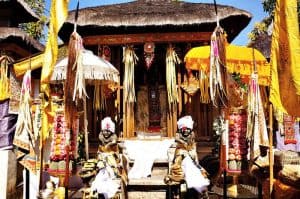 Odalan takes place almost twice according to Gregorian calendar year which each and every temples on the island has it own celebration also as primarily religious time. All religious icons and subjects are brought at decorations ranging from the bizarre to spectacular adorn the grey stone walls.
Odalan takes place almost twice according to Gregorian calendar year which each and every temples on the island has it own celebration also as primarily religious time. All religious icons and subjects are brought at decorations ranging from the bizarre to spectacular adorn the grey stone walls.
Beautiful gamelan sets also brought in to play music for the Gods, with dozens of uniformly dressed musicians sitting about waiting for their time to play ceremonial accompaniment and to provide music for the various dancers.
Odalan consist of worship services, presentations of such offering as food, money, and flowers in the temple. After the prayer, the ceremony will take a break and continue in the late afternoon with some performances until late night. Odalan also has great philosophical meaning that remind us about where we came from and the balance of the universe also its contents to the ceremony and offerings. Odalan ceremony can be seen by tourists and they have to use gloves also Bali headbands to respect the ritual.
Read also:
10. Full Moon Ceremony
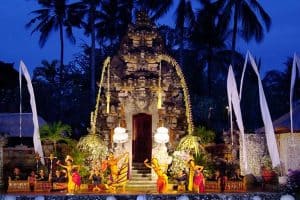 Full moon ceremony is also known as Purnama ritual considered as an suspicious day by the Balinese people, which many important Hindu ceremonies and rituals falls upon or held at this time. In the night, lot of pilgrims occupy not only the main worship area but also the surroundings. Purnama also considered as good day for planting – especially for plants that bear fruit so people very often delay the planting until the day of the full moon come so they are more assured of successful of harvest.
Full moon ceremony is also known as Purnama ritual considered as an suspicious day by the Balinese people, which many important Hindu ceremonies and rituals falls upon or held at this time. In the night, lot of pilgrims occupy not only the main worship area but also the surroundings. Purnama also considered as good day for planting – especially for plants that bear fruit so people very often delay the planting until the day of the full moon come so they are more assured of successful of harvest.
The full moon ceremony is held more intense in April and October which we also can see in that day both women and children are preparing flowers decorations, handicrafts, also sweet cakes with rices – while the men prepare typical Balinese dish with pork meal. In the day of the ceremony, the temples is decorated with golden fabrics and the women carry these offerings on top of their head also place them in strategic points of the temples. This day also a perfect occasion for wedding day.
See also:
11. Saraswati Ceremony
 This ceremony is devoted to Dewi Saraswati, the Goddes of Science and Knowledge. On the Saraswati day, the Balinese will make offerings for their books. On this day, pupils, college students, teachers, lecturers,priests and another Hindu communities will perform a worship. The celebration begin with a prayer requesting a blessing for peace and knowledge which has descended to earth.
This ceremony is devoted to Dewi Saraswati, the Goddes of Science and Knowledge. On the Saraswati day, the Balinese will make offerings for their books. On this day, pupils, college students, teachers, lecturers,priests and another Hindu communities will perform a worship. The celebration begin with a prayer requesting a blessing for peace and knowledge which has descended to earth.
In a series of this ceremony, the participants prepare herbal drink and pradnya rice which symbolize to experiencing the ups and downs in life. Saraswati ceremony will be followed by Banyupinaruh ceremony, which is devoted to flock the spring or water sources to do self purification. Four days after that, there will be held a Pangesweti ceremony which the ritual hope that knowledge will make people aware of their duty of their fellow being and that man will use the science for improvement, not for destruction.
See also:
12. Tumpek Landep Ceremony
 Tumpek landep is ceremonial day which offerings are made for objects that are made of metal. Tumpak landep is derived from the word “tumpek” which means close and “landep” which means sharp. Tumpak landep take place every 210 days according to ceremonial pawukon calendar, which is always at the Saturday of the second week. Most Balinese people truly believe that these ceremony and blessing will give them luck and keep them safe in traffic.
Tumpek landep is ceremonial day which offerings are made for objects that are made of metal. Tumpak landep is derived from the word “tumpek” which means close and “landep” which means sharp. Tumpak landep take place every 210 days according to ceremonial pawukon calendar, which is always at the Saturday of the second week. Most Balinese people truly believe that these ceremony and blessing will give them luck and keep them safe in traffic.
The aim of the ceremony is to honor Sang Hyang Pasupati, lord of Herlooms for the creation of steel goods. The ceremony start in the morning hour at the village temple when people gather for special prayers and blessings. Additional ceremonies and blessings follow at which offerings are made for the holy family keris that most family own but also for cars and motorbikes.
In this day, we can see around if Bali cars and motorbikes are dressed with attractive offerings and an arrangements of colorful decoration. Today, this ceremony is believed thats means of revitalize the magical powers of the metallic tools and to sharpen people is minds and hearts, as they are ultimate the use of technology and machinery. People also expected to fight against misery, darkness, and ignorance to suppress the evil behavior within themselves and choose what is good and bad.
Read also:
13. Ngerebeg Ceremony
 This ceremony has meaning as expression of gratitude, where the childrens deliver the offerings in the morning and will carry it out in the afternoon. This ceremony is start in front of Dusur Bingin temple and walked along 10 km surround Tegal alang village. Hundreds of peoples, mostly of 3 to 15 years old are gathered in the inner courtyard of Dusur Bingin temple in Tegalalang village. They were dressed in traditional clothes and some of them are bare chested. The boy had painted their face and bodies with colorful images and pattern. Every children is carried a slender staff made from the branch of palm which decorated with colorful flowers and young coconut leaves.
This ceremony has meaning as expression of gratitude, where the childrens deliver the offerings in the morning and will carry it out in the afternoon. This ceremony is start in front of Dusur Bingin temple and walked along 10 km surround Tegal alang village. Hundreds of peoples, mostly of 3 to 15 years old are gathered in the inner courtyard of Dusur Bingin temple in Tegalalang village. They were dressed in traditional clothes and some of them are bare chested. The boy had painted their face and bodies with colorful images and pattern. Every children is carried a slender staff made from the branch of palm which decorated with colorful flowers and young coconut leaves.
This ceremony begin with distribution of derty’s blessy by magibung ritual (eating together) where 6-8 boys formed sit together. After magibung, the boy lined up in front of temple to receive purification ritual with holy water by the priest. Afterwards, the procession continue with horsuy procession which is more than five hundreds childrens in the main streets make noises and sometime stopped in front of temple to pay homage. This ceremony usually lasted for three hours and end in Dusur Bingin temple.
See also:
14. Mekare-kare Ceremony
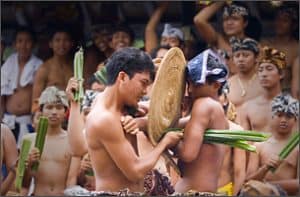 This ceremony also known as Perang Pandan which usually helds anually in June in the village of Tenangan. Mekare-kare is one of ritual during the ceremony where two Tenganese men duel. This ritual is to demonstrate respect to the God Indra, the Hindu God of War.
This ceremony also known as Perang Pandan which usually helds anually in June in the village of Tenangan. Mekare-kare is one of ritual during the ceremony where two Tenganese men duel. This ritual is to demonstrate respect to the God Indra, the Hindu God of War.
Recently, locals said this ceremony is to impress the village’s unmarried women. The man’s fight including sharp pandan leaves, bamboo shield, and accompanied by native gamelan music “selonding”. The fight usually lasted only for couple minutes and the participants are male teenagers to whose already 30 years old. This ritual usually start around 2 PM and held for two days. The ceremony ended by praying together at local temple and performing Rejang dance.
Read also:
And thats all some traditional and cultural ceremonies from Bali. Beautiful one, right? It would be unforgetable memories when we can see the ceremonies by ourself. So, lets explore more about Indonesia and be ready to know of the beauty and the uniqueness!
